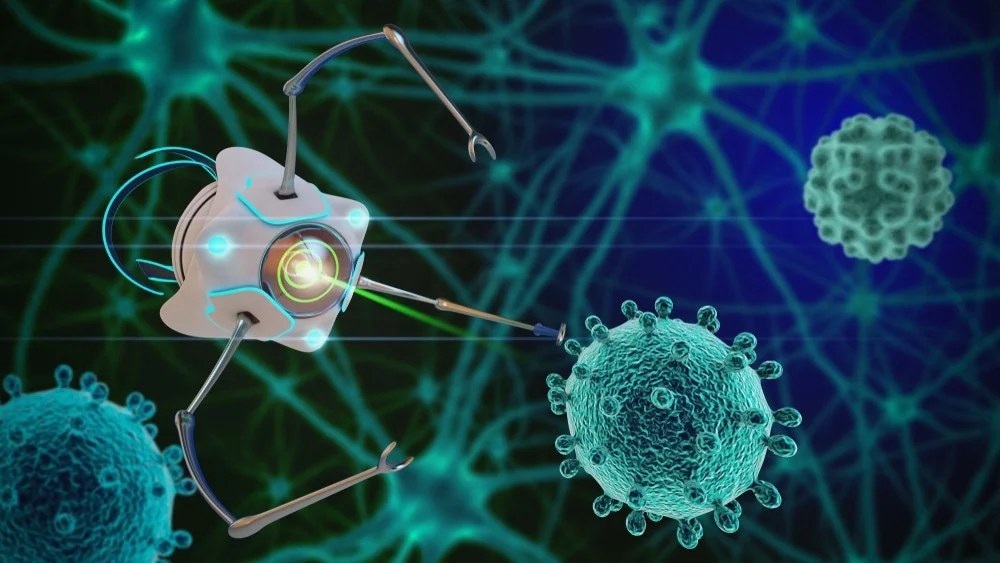
Nanorobots, the hidden gems of modern medical science, are poised to revolutionize healthcare by leveraging their microscopic prowess to navigate through the human body and perform intricate tasks. These minuscule wonders hold the potential to diagnose diseases at their earliest stages, deliver targeted treatments, and even repair damaged cells. In this blog, we embark on a captivating journey into the world of nanorobots, unearthing their capabilities, applications, and the exciting future they promise.
Unveiling the Marvels: Nanorobots at a Glance
Nanorobots, or nanobots, are infinitesimal devices engineered to carry out specific tasks at the nanoscale, measuring just a fraction of a millimeter. Often inspired by nature’s mechanisms, these tiny machines are designed to operate autonomously, guided by advanced algorithms and intricate programming. Their remarkable maneuverability allows them to navigate through the bloodstream, delivering drugs precisely to targeted cells or tissues.
Exploring Applications: The Hidden Gems of Healthcare
The potential applications of nanorobots within healthcare are astonishingly diverse:
Disease Detection and Diagnosis: Nanorobots equipped with sensors can detect biomarkers indicative of diseases like cancer, providing early diagnosis with unprecedented accuracy.
Targeted Drug Delivery: These microscopic marvels can transport drugs directly to affected areas, minimizing side effects and enhancing the effectiveness of treatments.
Cellular Repair and Regeneration: Nanorobots can facilitate cellular repair by mending damaged DNA strands or assisting in tissue regeneration processes.
Surgery on a Microscopic Scale: With their precision and dexterity, nanorobots can perform intricate surgical procedures at the cellular level, reducing invasiveness and recovery times.
The Inner Workings: How Nanorobots Operate
Nanorobots are engineered using advanced materials such as carbon nanotubes and polymers. Their propulsion systems vary, including flagella-like structures, magnetic guidance, or even chemical reactions. These mechanisms enable nanorobots to navigate within the body, overcoming obstacles and reaching targeted sites with remarkable precision.
Overcoming Challenges: Ethical and Technical Considerations
While the potential of nanorobots is thrilling, ethical concerns and technical hurdles must be addressed. These include ensuring the safe disposal of nanorobot waste, preventing unintended harm, and managing the potential for misuse. Moreover, intricate programming and communication between nanorobots demand further advancements in nanotechnology.
A Glimpse into the Future: Nanorobots Redefining Medicine

As research progresses, the integration of nanorobots into mainstream medicine seems inevitable:
Personalized Medicine: Nanorobots could enable tailoring treatments to an individual’s genetic makeup, maximizing effectiveness.
Minimally Invasive Procedures: Surgical procedures could become less invasive, with nanorobots performing tasks that previously required open surgeries.
Real-time Monitoring: Nanorobots may offer real-time monitoring of vital signs, allowing for immediate interventions in critical situations.
Final Words
In the realm of healthcare, nanorobots emerge as hidden gems with the potential to transform medical practices. These microscopic wonders offer a glimpse into a future where disease detection and treatment are more precise, surgical procedures are less invasive, and personalized medicine becomes the norm. While challenges persist, the ongoing progress in nanotechnology promises a brighter and healthier future for humanity.
Commonly Asked Questions
Q1: Are nanorobots already being used in medicine?
A1: While there’s ongoing research, nanorobots have not yet been widely implemented in clinical settings. However, experiments in laboratories and animal studies show promising results.
Q2: Can nanorobots replace traditional surgeries?
A2: While nanorobots hold potential for minimally invasive procedures, they are unlikely to entirely replace traditional surgeries. Instead, they might complement existing techniques.
Q3: How do nanorobots communicate with each other?
A3: Nanorobots can communicate using various methods, including chemical signals or electromagnetic waves, allowing them to work together on complex tasks.
Q4: Are there any risks associated with nanorobot technology?
A4: Like any new technology, there are risks to consider. Ensuring nanorobot safety, preventing unintended effects, and addressing ethical concerns are crucial.
Q5: When can we expect nanorobots to be widely used?
A5: The timeline for widespread use of nanorobots in healthcare is uncertain. It depends on further research, regulatory approvals, and technological advancements.












